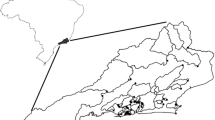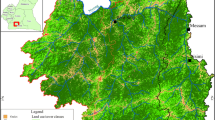Abstract
Land-use and vegetation cover have been linked to the nutrient levels (nitrogen, phosphorus) of surface waters in several countries. However, the links generally relate to streams and rivers, or to specific types of standing water, for example shallow lakes in a geologically defined region. We measured physical variables and nutrient chemistry of 45 water bodies representative of the wide range of lentic wetland environments (swamps, riverine wetlands, estuaries, reservoirs, shallow lakes, deep lakes) in Otago, New Zealand, and related these to catchment variables and land-use in order to assess the potential influence of catchment modification on water quality of these diverse wetlands. Catchment boundaries and land cover were derived from maps using ArcView GIS software. Our predictions that concentrations of nutrients and other components of water quality would correlate positively with the nature and intensity of catchment modification were confirmed in multivariate analyses. Physical and chemical measures were positively related to the extent of modification in the catchment (percentage of the catchment in pasture, planted forest, scrub and urban areas), and negatively related to lack of catchment modification (more of the catchment in bare ground, tussock grassland and indigenous forest). The strong negative correlations between nutrient concentrations, suspended sediment, water colour and the percentage of tussock cover in the catchment imply that increased conversion of the␣native tussock grassland to pastoral farming in␣Otago will increase nutrient concentrations and␣reduce water quality of the diverse lentic ecosystems.
Similar content being viewed by others
References
Cuthbert I, del Giorgio P (1992) Toward a standard method of measuring color in freshwater. Limnol Oceanogr 37:1319–1326
D’Arcy P, Carignan R (1997) Influence of catchment topography on water chemistry in southeastern Québec Shield lakes. Can J Fish Aquat Sci 54:2215–2227
Elliott S, Sorrell B, (2002) Lake Managers’ handbook, land–water interactions. Ministry for the Environment, Wellington, New Zealand
Huryn AD, Burns CW, Allibone R, Patrick B, Scott D (2003) Inland waters and wetlands. In: Darby J, Fordyce RE, Mark A, Probert K, Townsend C (eds) The natural history of Southern New Zealand. Otago University Press, Dunedin, New Zealand, pp 237–265
Johnes PJ, Moss B, Phillips G (1996) The determination of total nitrogen and total phosphorus concentrations in freshwaters from land-use, stocking headage and population data: testing of a model for use in conservation and water quality management. Freshwater Biol 36:451–473
Lougheed VL, Crosbie B, Chow-Fraser P (2001) Primary determinants of macrophyte community structure in 62 marshes across the Great Lakes basin: latitude, land use, and water quality effects. Can J Fish Aquat Sci 58:1603–1612
Maberly SC, King L, Gibson CE, May L, Jones RI, Dent MM, Crawford J (2003) Linking nutrient limitation and water chemistry in upland lakes to catchment characteristics. Hydrobiologia 506–509:83–91
Menzel DW, Vaccaro RF (1964) The measurement of dissolved organic and particulate carbon in sea water. Limnol Oceanogr 9:138–142
Moss B (1998) Ecology of Fresh Waters: man and medium, past to future, 3rd ed. Blackwell Science, Oxford, UK
Newsome PFJ (1987) Vegetation cover of New Zealand. Water and soil miscellaneous publication No. 112, Wellington, New Zealand
Prepas EE, Planas D, Gibson JJ, Vitt DH, Prowse TD Dinsmore WP, Halsey LA, McEachern PM, Paquet S, Scrimgeour GJ, Tonn WM, Paszkowski CA, Wolfstein K (2001) Landscape variables influencing nutrients and phytoplankton communities in Boreal Plain lakes of northern Alberta: a comparison of wetland- and upland-dominated catchments. Can J Fish Aquat Sci 58:1286–1299
Rasmussen JB, Godbout L, Schallenberg M (1989) The humic content of lake water and its relationship to watershed and lake morphometry. Limnol Oceanogr 34:1097–1103
Riley RH, Townsend CR, Niyogi DK, Arbuckle CA, Peacock KA (2003) Headwater stream response to grassland agricultural development in New Zealand. New Zeal J Mar Freshwater Res 37:389–403
Schindler DW (1997) Widespread effects of climatic warming on freshwater ecosystems in North America. Hydrol Process 11:1043–1067
SPSS (2000) SPSS for Windows, Version 10.1.0. 2000. SPSS Inc
ter Braak CJF, Šmilauer P (1998) CANOCO reference manual and user’s guide to Canoco for Windows. Centre for Biometry, Wageningen, The Netherlands
Thomas JD (1997) The role of dissolved organic matter, particularly free amino acids and humic substances, in freshwater ecosystems. Freshwater Biol 38:1–36
Thompson RM, Townsend CR (1998) The effects of land use on stream community attributes. Taieri Catchment Symposium, Ecology Research Group, University of Otago, Occasional paper 1:44–45. Dunedin, New Zealand
Tong STY, Chen W (2002) Modeling the relationship between land use and surface water quality. J Environ Manage 66:377–393
Townsend CR, Niyogi D, Riley RH, Koren M (2001) Land-use impacts on streams. Unpublished fact sheet available as PDF on website of Ecology Research Group, University of Otago, Dunedin. www.otago.ac.nz/erg/freshwater/
Valderra JC (1981) The simultaneous analysis of total nitrogen and total phosphorus in natural waters. Mar Chem 10:109–122
Wetzel RG (1995) Death, detritus and energy flow in aquatic ecosystems. Freshwater Biol 33:83–89
Wetzel RG, Likens GE (1991) Limnological analyses, 2nd ed. Springer-Verlag, New York
Wickham JD, Riitters KH, Wade TG, Jones KB (2005) Evaluating the relative roles of ecological regions and land-cover composition for guiding establishment of nutrient criteria. Landscape Ecol 20:791–798
Young RG, Huryn AD (1999) Effects of land-use on stream metabolism and organic matter turnover. Ecol Appl 9:1359–1376
Acknowledgements
We thank Chris Arbuckle for help with GIS, Carleen Mitchell for nutrient analyses, Jo Bishop, Nathan Whitmore and Catherine Hall for field assistance, and Marc Schallenberg for technical advice. LG was supported by a University of Otago Postgraduate Scholarship.
Author information
Authors and Affiliations
Corresponding author
Rights and permissions
About this article
Cite this article
Galbraith, L.M., Burns, C.W. Linking Land-use, Water Body Type and Water Quality in Southern New Zealand. Landscape Ecol 22, 231–241 (2007). https://doi.org/10.1007/s10980-006-9018-x
Received:
Accepted:
Published:
Issue Date:
DOI: https://doi.org/10.1007/s10980-006-9018-x




